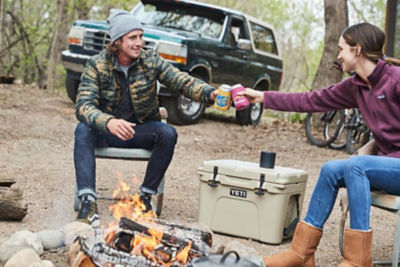How to Waterproof Your Boots
Find the right treatment for your boots and learn how to regularly clean them to help keep your feet dry and comfortable.

There are few things that can ruin your day faster than a pair of cold, wet socks. Moisture penetrating your boots can cause some uncomfortable situations and can even create the perfect environment for blisters to possibly form.
But by waterproofing your footwear properly, soggy feet should be a distant memory.
Whether your boots are for hiking, working or just combating the elements, there’s a good chance they came with an initial waterproofing treatment already on them. But to help keep your feet dry for the long term, you’ll need to treat them regularly.
How often you’ll need to waterproof your boots will depend on how often you wear them. A good rule of thumb is to waterproof your boots whenever they get extra dirty or when water stops beading on their surface. This may equate to waterproofing them once every couple of months.
It’s important to know what your boots are made of before you treat them. Each type of material needs a different product to help waterproof. Full-grain leather — probably the most common material used in boots — may need a different treatment than suede or nubuck leather. Some boots are even made of fabric or synthetic materials. We’ll break this down more below.
If you ever doubt what your boots are made of, the manufacturer's website should have that information for you.
MAKE SURE YOUR BOOTS ARE CLEAN
Before you start the waterproofing process, give your boots a thorough cleaning. Dirt and grime can get in the way of the waterproofing product, causing the treatment to not fully cover the boots. It is always a good idea to keep your boots clean to extend their lifespan.
Start by removing the laces and using a brush to remove any dirt or grime. If the soles of the boots are caked with dirt, place them in about an inch of water for a few hours to loosen the crud. Any remaining dirt can then be removed by spraying it with a hose.
Leave your boots to air dry, but come back to them while the leather is still a little bit damp. This will help pull the treatment into the material.
THE WATERPROOFING PROCESS
Make sure you have the right product for your type of boots. There are several types of waterproofing treatments out there, and each one is applied in a different way:
- Spray – There are sprays made specifically for leather, suede and synthetic materials. To use, hold the can about six inches from the boot and spray them with a thin, even coat. Check the product directions to see if a second coat is required.
- Wax – Wax best suits leather and suede boots. If you use a wax to waterproof your boots, warm it slightly with a hairdryer and apply it with a clean cloth. Remove any excess wax and buff to shine. Applying wax can be more of a manual process, but it’s great at working its way into more of the nooks and crannies.

- Cream – This is a great option if you have a pair of leather boots. To use a cream to waterproof your boots, apply with an applicator that comes with it or a clean cloth, and rub the product across the entire boot. If you have a boot with a hard-to-reach area, get into the crevice with a clean cloth.
Some products will cause your boots to have a slightly darker tone. Read all labels and test the product in a small area to make sure it is to your liking before proceeding.
No matter what type of product you use, make sure to cover the entire boot. Pay close attention to seams and creases. These areas can be prone to leaking from the material being punctured or bending.
DRYING
After applying the treatment, your boots will need time to dry completely. Place them in an area with average temperatures, low humidity and good ventilation.
Never use direct heat, like a hair dryer, to speed up the drying process since this can cause the glue of your boots to loosen or the leather to crack. You should also avoid drying your boots in direct sunlight.
You can, however, use a fan to help speed up the drying process. Placing balled up newspaper in the boots is a good way to absorb moisture and is particularly effective in helping to dry the insole.
Once you clean, treat and dry your boots, they will be ready for you to throw them on and make a splash.
Now throw them on and get ready to tackle all the winding trails, looming mountains and roaring streams you encounter on your next excursion to the great outdoors.










